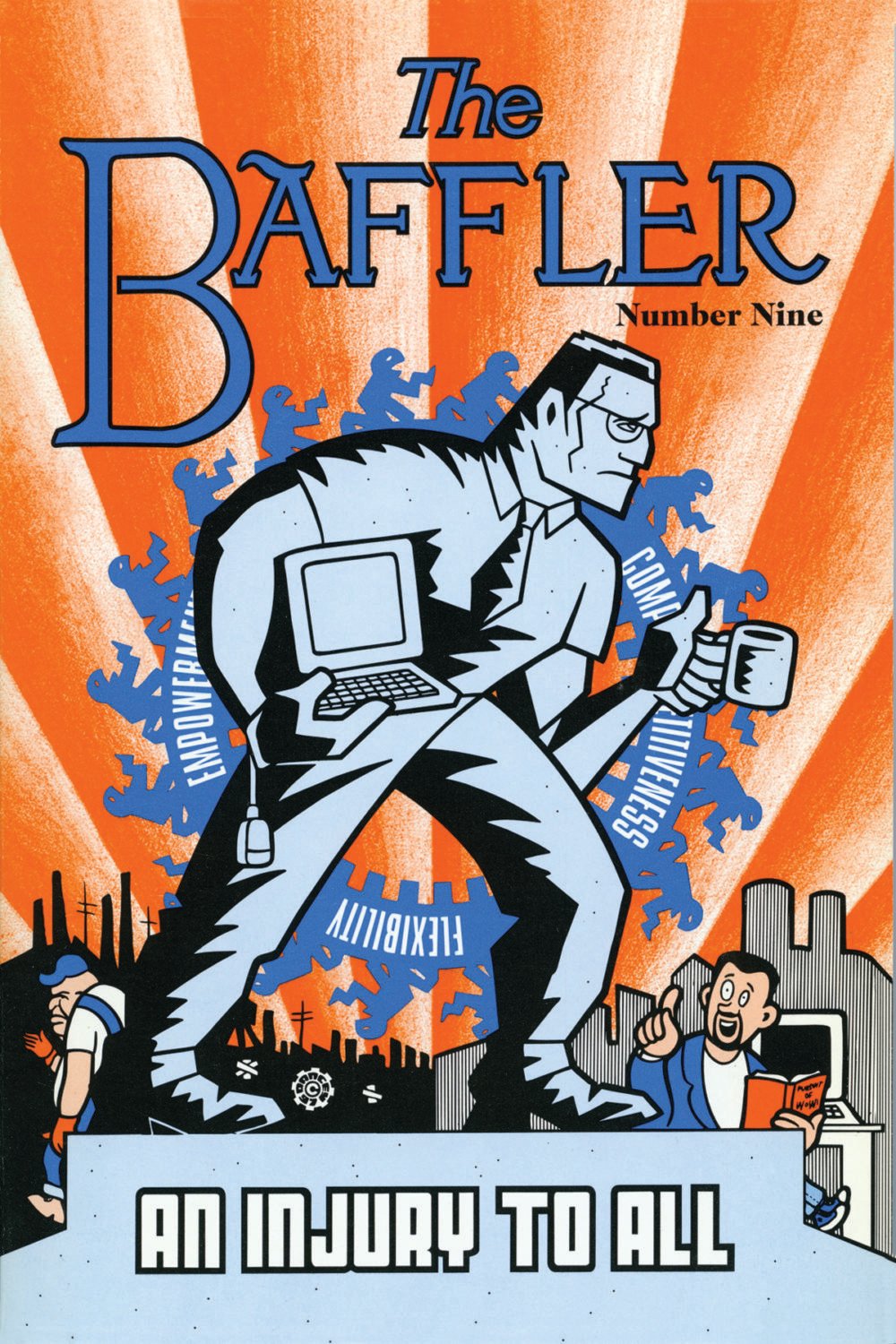Labor Day Reading from The Baffler

Happy Friday, all! If you find yourself with some extra time over this long Labor Day weekend, why not take a moment to think about the reason for the season?
These classic salvos from The Baffler all happen to be from issue 9 of The Baffler, a labor-themed issue we published in 1997. (This same issue also features Tom’s Vanderbilt’s take on Dilbert, and one of the best and most important pieces we’ve ever run, “Internment Camp” by the late great Jim Frederick, come to think of it.)
In “Confessions of a Labor Editor,” Jim McNeill writes about his time at Racine Labor in Wisconsin, covering union issues in the Rust Belt (including that one time he wrote a letter to the editor of the Wall Street Journal in response to a particularly tone-deaf column there, and accidentally became a folk hero). As he learned the ropes, one retired union leader shared with him the secret of any successful strike: “Solidarity, sabotage, and vandalism.”
Here’s an excerpt of McNeill’s piece where he’s remembering a strike at a car dealership, Frank Gentile Oldsmobile:
Life on the picket line at Frank Gentile Oldsmobile had been fun at first. For two weeks, the strikers had wandered up and down Highway 20, enjoying the mercifully warm Wisconsin spring, waving righteously at the union faithful who honked as they went by. The Gentile pickets even had fun flipping off scabs as they drove into the dealer’s lot. But then, while a dozen Teamsters meandered slowly past the side entrance, a scab gunned his car through the picket line, plowing a striker up on the hood and depositing him back on the pavement.
The striker, bruised but not badly hurt, was still screaming about it when I showed up with my notebook. “These people are willing to kill you. Literally fucking kill you!” Of course, the company didn’t really want to kill him. Gentile was happy to just permanently replace him instead.
In the negotiations leading up to the strike, the Olds dealer called in Wisconsin’s premier union-busting law firm to bargain with the Teamsters. The union asked for a modest raise in its hourly wage. Gentile’s attorneys countered by saying they were going to wipe out the hourly wage altogether and replace it with a piece-work pay scheme. With some workers likely to lose as much as $10,000 a year, the Teamsters decided they had to strike.
It’s a decision that very few unions are still willing to make. In 1977, there were 3,111 work stoppages in the United States. In 1981, however, Ronald Reagan famously replaced the nation’s striking air traffic controllers and wiped out their union. Companies across the country quickly followed Reagan’s lead, seeing every strike as an opportunity to destroy their unions. By 1996, the number of walkouts was down to 372. As the Gentile strike entered its second month, and the company showed no signs of settling, I began to understand why unions stopped striking.
Bob Fitch’s “Why Johnny Can’t Organize” took a critical look at John Sweeney, then-president of the AFL-CIO, as well as at “the yawning gap between labor’s means and its ends” in general:
What distinguishes American unions from unions elsewhere is not just that they don’t have a labor party. It’s not just their weak leverage in a weak state. What really marks them is their peculiar localistic character.
But what’s wrong with local unionism? Won’t local leaders be closer to members than remote bureaucrats off in some D.C. headquarters? Maybe, but at the same time, American unions have not only the most highly paid leaders, but the most staff, and the most highly paid staffs in the world.
These bloated staffs don’t make American unions “bureaucratic.” To be bureaucratic requires centralization, the power to administer a law or a contract. The fragmentation and competitive relations between American unions makes real bureaucratic administration impossible. The staff people aren’t true bureaucrats. They constitute a kind of patronage machine. […]
America is a big country that’s never been organized. We’ve always had a core of craft and locally based unions like the Teamsters. But even in the 1930s, we never fully reached the stage of national bargaining. The UAW and the Steelworkers stopped at the Mason-Dixon line.
Finally, you’ll want to read “When Class Disappears,” by Thomas Frank, which helps remind us why we need reminding about labor issues in the first place—because the mainstream news media simply doesn’t cover it. This was true in 1997, and it’s even truer in 2014.
Here, Frank discusses the Detroit newspaper strike of 1996-7, when six newspaper unions walked off the job at Knight-Ridder- and Gannett-owned papers.
It’s not a coincidence that the most important labor struggle of the mid-Nineties is taking place in the information industry, and specifically within the smiling newspaper empires of Knight-Ridder, publisher of the Free Press, and Gannett, genius producer of both the News and USA Today. Labor is becoming invisible here, and the strikers know it. […]
In February 1997, the strikers made an offer to return to work unconditionally (at press time, only a handful have been taken back) and newspapers around the country have quickly decided that the time is finally right to cover the Detroit newspaper strike. When it comes, though, their reporting is wrapped in a mythological package so uniform and so smugly confident of the direction in which civilization is heading that it reminds me of the black-clad Vance guards on the roof of the News building, filming and chewing. Hear the new breed of journalists confront the big questions: What is labor? Why, labor is a relic of the deluded Thirties. What are strikes? Why, strikes are sad.
Have a great long weekend, you workers of the world. If you want more to read, check out the rest of our labor-themed issue here.